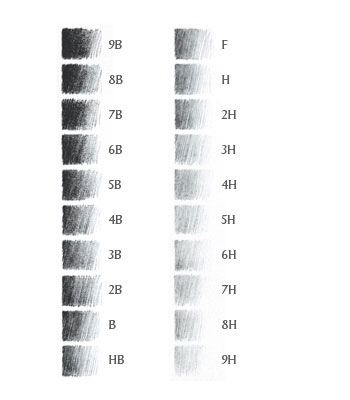Graphite 101
Graphite is made from the exact same element as diamonds – both are pure carbon. The only difference is how they’re constructed.
There are many great websites out there that talk about pencil graphite in detail, so I’m going to keep this pretty simple.
The quality of the graphite in your pencil is everything. Some pencils are smooth to write with, some are waxy, some are rough. Some wear down very quickly, some you can write with for hours and never sharpen—referred to as point retention. Typically the ‘harder’ the pencil, the better the point retention—but that’s not always true. Often the softer the pencil is, the easier it will be to smudge. This is an important point for left-handers who need to find a balance between darkness and smudginess.
People prefer different things, for different purposes. It’s worth trying a variety of pencils. It’s easy to see the difference between a high-quality pencil like Mitsubishi or Caran d’Ache and the ‘cheap and nasties’ from the local supermarket or variety store.
The graphite inside a pencil is essentially a mix of graphite and clay. Graphite is Carbon – the same chemical element as diamond – but with different chemical structure. Lead pencils have never contained lead, but were sometimes coated in lead paint. The softer the pencil (B, 2B, 3B etc), the more graphite than clay. The harder the pencil (H, 2H, 3H etc), the more clay than graphite. The odd one out in the list of graphite grades is the ‘F’ which sits between HB and H on the ‘harder’ side.
There is no international standard for the grading of graphite. A Japanese HB pencil might be similar to a 2B European pencil. Grades are relative to one-another in the same product line, and are not the same across brands and may even differ in product lines in the same brand. American pencils tend to use grades 1-4 for writing pencils, with 1 being the softest (around a B) and 4 being the hardest (around 2H).
Staedtler Lumograph currently offer pencils across 24 grades from 12B to 10H. Mitsubishi Hi-Uni offer pencils across 22 grades from 10B to 10H. Derwent and Koh-i-Noor offer pencils across 20 grades. Typically a ‘writers’ pencil is either HB or F, however there are no rules. One of my preferred writing pencils is the Faber-Castell 9000 2B – intended as a drawing pencil.
The best way to discover what you like is to try different things – you never know what you’ll be inspired to create!

